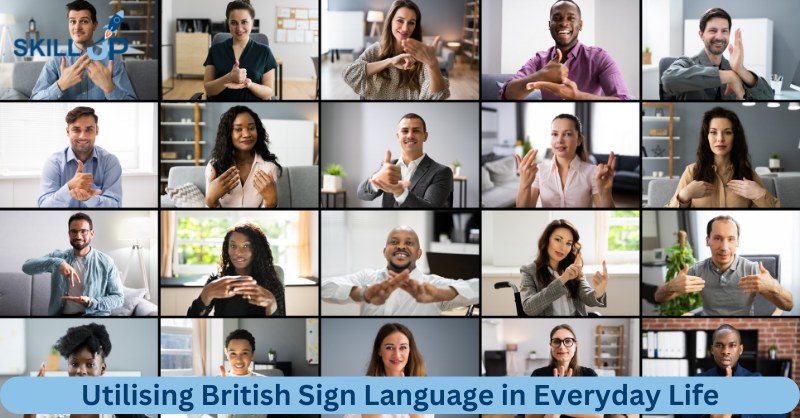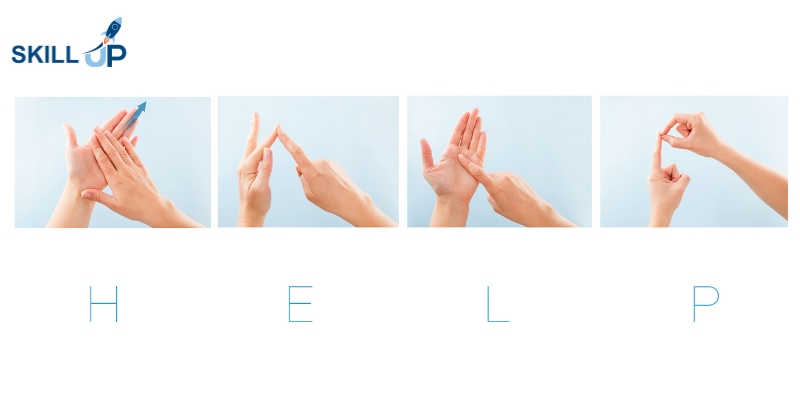
Imagine a language painted in the air, a picturesque symphony of hands, facial expressions, and body language. This beautiful and expressive medium is none other than British Sign Language (BSL), a rich form of communication widely used by the Deaf community and others in the United Kingdom. Distinct from American Sign Language (ASL) and other international sign languages, BSL is a signature language embedded with the cultural nuances of British people.
BSL showcases a diverse vocabulary, from the basics like ‘hello’ and ‘thank you,’ to expressions of profound sentiments such as ‘I love you’. Indeed, even the emotion of happiness can be conveyed in the graceful ballet of signing hands. Its alphabet, articulated through distinct hand shapes, is as elegant as it is accessible, with even babies able to grasp rudimentary baby sign language.
The world of BSL is not limited to the Deaf community, as many hearing individuals find it a rewarding language to learn, utilising online resources and in-person courses to gain proficiency. From the ‘fist’ to the ‘palm’, every gesture adds another word to your BSL vocabulary.
Table of Contents
The Importance of Learning British Sign Language
Unlocking BSL is more than learning another language; it’s bridging a divide between the hearing and the Deaf, fostering inclusivity, and challenging disability stereotypes. Learning sign language brings with it the understanding that communication extends beyond sound.
Courses in BSL are readily available, and not just in a physical classroom. The digital age allows for online training and resources, including the British Sign Language dictionary and various sign language courses, making it possible for anyone to learn BSL.
More than just a course, BSL is a gateway to understanding Deaf culture. The language is intrinsically linked with the experiences and history of the Deaf community, and learning it offers a chance to foster empathy and understanding.
Understanding Deaf Culture and Hearing Loss
The Deaf community is not defined by hearing loss but by a shared culture and language. It is a vibrant community that celebrates diversity and promotes equality. Deaf Awareness Week, an annual event, is a testament to the strength and vitality of this community.
Hearing loss isn’t a barrier to communication, but rather an invitation to explore different forms of expression. The universality of signs, from BSL and ASL to Makaton and Auslan, showcases the adaptability and resilience of humans. It’s a reminder that language, in all its forms, is an instrument of love, understanding, and connection.
Through the lens of BSL, we can grasp that the essence of communication transcends auditory boundaries. By learning and using British Sign Language, we build bridges, empower individuals, and embrace a world where everyone’s voice can be ‘heard’ – through the flutter of fingers, the wave of a palm, or the flex of a thumb.
Getting Started: An Overview of Sign Language
The Diversity of Sign Languages: From ASL to BSL and Makaton
The world of sign language is as diverse as it is beautiful. It’s a melting pot of cultural expressions, individualistic gestures, and unique linguistic systems. American Sign Language (ASL), British Sign Language (BSL), Makaton, Auslan, and more, each carry their unique dialects and vocabularies, mirroring the rich tapestry of human cultures.
BSL, used extensively across the United Kingdom, possesses its distinct alphabet and grammatical structure, reflecting the idiosyncrasies of British English. At the same time, ASL, used predominantly in the United States and parts of Canada, displays influences of French Sign Language.
Makaton, meanwhile, is a language program that uses signs and symbols to help people communicate. It is designed to support spoken language and the signs and symbols are used with speech in spoken word order.
The Question of Universality in Sign Language
So, is sign language universal? The answer is no. Sign language, like spoken languages, varies across regions. For instance, the ‘thank you’ in ASL may differ from its counterpart in BSL or Makaton. Even the ‘I love you’ sign, laden with emotion, varies across cultures.
However, international events like Eurovision and Glastonbury have seen interpreters seamlessly translating languages into BSL, demonstrating the potential for cross-cultural sign language communication.
The Legacy of British Sign Language in the United Kingdom
Despite its diversity, British Sign Language holds a special place in the hearts of the British people. BSL isn’t merely a communication tool, it’s a cherished cultural asset that carries the legacy of the Deaf community within the United Kingdom.
From introducing the BSL alphabet to primary school children to hosting BSL courses for adults, the United Kingdom is continually striving to elevate the understanding and usage of BSL. Moreover, annual events like Deaf Awareness Week serve as platforms to celebrate the language and the culture it represents.
The journey of learning BSL is not merely about mastering signs, it’s about appreciating a different perspective of life. So whether it’s greeting someone with a ‘good morning’ in sign language or expressing ‘love’ in BSL, every sign, every gesture, every palm movement is a step towards creating a more inclusive society.

Diving into British Sign Language Level 1
A Glimpse into the BSL Level 1 Online Course
The journey of understanding the silent melodies of British Sign Language begins with the BSL Level 1 course. Tailored for beginners, this course, available both in-person and online, sets the foundation for the linguistic voyage ahead.
Mastering the Alphabet: Finger spelling and Name Practice
BSL is a visual language and starts with the fundamentals: the alphabet. Through finger spelling, each letter of the British English alphabet is assigned a unique hand shape, all waiting to be learned and practiced.
Understanding how to sign your name is an empowering first step in this journey. It signals the beginning of personal expression within the realm of BSL.
Everyday Conversations: Greetings, Questions, and Dialogues
Moving beyond individual letters, BSL Level 1 dives into the dynamics of everyday conversation. From greeting a friend with a simple ‘hello’ to more complex dialogues, students can begin engaging in real-time communication.
The key to conversation in BSL, just like any language, lies in asking and answering questions. Whether it’s a friendly enquiry about one’s wellbeing or a more complex discussion, learning to ask and respond to questions forms the cornerstone of BSL.
Building Your Vocabulary: Family, Home, Animals, Numbers, Time, and More
A new language is nothing but a blank canvas waiting to be painted with words. As you delve deeper into BSL, you’ll start amassing a vibrant vocabulary: family, home, animals, numbers, time, and many more. Every new sign learned, every word added, will only make your BSL conversations more colourful and engaging.
Interactive Learning: Level 1 Dialogues with and without Voice and Subtitles
Learning BSL is as interactive as it is fun. Level 1 offers dialogue practice, both with and without voice and subtitles. This immersive experience strengthens your understanding, encourages real-time practice, and fosters better sign language interpretation skills.
Engaging the Learner: Bonus BSL Stories with Diverse Formats
Finally, every BSL course aims to keep the learning engaging. Level 1 offers bonus BSL stories in diverse formats. These stories not only enrich your vocabulary but also introduce you to the narrative style of BSL. This captivating learning approach ensures that the learner remains intrigued and engrossed, paving the way for a smooth transition to BSL Level 2.
Exploring Further: British Sign Language Level 2
The Next Step: BSL Level 2 Course
After successfully completing Level 1, your linguistic adventure in the silent world continues with the British Sign Language Level 2 course. This next step deepens your understanding of BSL and equips you with more complex conversational skills.
Expanding Your Lexicon: People, Animals, School, Work, Home, and Leisure Activities
With Level 2, you’ll embark on a lexical expansion. This stage focuses on everyday life, introducing signs for people, animals, school, work, home, and leisure activities. Each new word is a tool for expression, helping you paint vivid narratives with your hands.
Speaking Your Mind: Expressing Opinions, Likes, and Dislikes in BSL
Language is all about expressing your thoughts and feelings. In BSL Level 2, you’ll learn to express opinions, likes, and dislikes. Love ice cream? Prefer cats over dogs? Now you can communicate these personal preferences confidently in BSL.
Navigating Everyday Scenarios: Health, Food, Shopping, and Travel
Practicality takes the front seat in this stage. BSL Level 2 helps you navigate everyday scenarios, such as discussing health, talking about food, shopping, and even describing your travels. All these combine to provide you with the necessary toolkit for day-to-day interactions in BSL.
Advanced Training: Level 2 Dialogues and Stories in Different Formats
Towards the end of the course, you’ll immerse in more complex dialogues and stories. This advanced training helps solidify your grasp of BSL. The dialogues come in various formats, challenging you to adapt and grow your language skills.
The BSL Level 2 course is designed to propel you further into the expressive world of British Sign Language. It takes you beyond the basics, empowering you to engage more deeply with the Deaf community and opening doors to new opportunities and connections.

Beyond the Basics: Special Topics in British Sign Language
Babies and BSL: The Importance of Baby Sign Language
When we delve into the domain of babies and British Sign Language (BSL), we uncover the profound benefits of teaching baby sign language. From as early as six months, babies can learn to communicate their needs through signs, often before they can articulate words vocally. This early language acquisition reduces frustration, enhances bonding, and paves the way for effective communication, enriching the baby’s developmental journey.
Love and Happiness in BSL: Expressing Emotions through Signs
Beyond the basics, BSL becomes a colourful palette of emotions. Learning how to express love, happiness, and other emotions through sign language is an enriching experience that deepens our interpersonal communication. From the simple sign of “I love you” to the expression of sheer happiness, BSL offers nuanced ways of expressing human sentiments and experiences.
A Look at Special Events: Eurovision, Glastonbury, and Deaf Awareness Week
In the United Kingdom, events like the Eurovision Song Contest, the Glastonbury Festival, and Deaf Awareness Week often include sign language interpretation to promote inclusivity. These platforms embrace BSL, ensuring the Deaf and hard-of-hearing community can fully enjoy these social spectacles. They stand as grand examples of society’s efforts to break down barriers and foster a world where everyone belongs.
These advanced topics in British Sign Language open up a new realm of possibilities and showcase the language’s broad application in various areas of life. From early communication in babies to expressing complex emotions and experiencing significant cultural events, BSL proves to be a vital means of connection, breaking the silence with a flourish of hands and fingers.
Practical Use and Benefits of Learning BSL
Bridging Communication Gaps: The Role of Sign Language Interpreters
Sign language interpreters are the unsung heroes who bridge the divide between the Deaf and hearing communities. By learning British Sign Language (BSL), they provide a critical service, making it possible for the Deaf to navigate a world steeped in sound. These experts are often seen in action during crucial meetings, special events, or television broadcasts, ensuring accessibility and inclusivity are upheld in every facet of society.
Disability and BSL: Enhancing Accessibility and Inclusion
When it comes to disability and BSL, there’s a positive correlation that has been built over the years. With a significant number of individuals experiencing hearing loss in the United Kingdom, BSL becomes a vital tool for communication. This language is not merely a series of signs, but a powerful bridge towards a more inclusive society. BSL empowers people with hearing loss, giving them the chance to fully participate in social, educational, and professional situations. As such, BSL training and courses have become increasingly prevalent, leading to better social integration and richer life experiences for individuals with hearing disabilities.
Advantages of Learning BSL for British People and Beyond
Lastly, the benefits of learning BSL are not exclusive to the Deaf community. For British people and beyond, BSL offers an exciting new language to explore, with its unique grammar and syntax, different from spoken British English. More importantly, it enables better interaction and understanding of the Deaf culture. Even for those without hearing loss, this skill enhances one’s ability to communicate in quiet environments, like libraries or late at night when silence is golden. Additionally, BSL courses can be a springboard for careers in sign language interpretation, special education, or even community development.
The power of British Sign Language extends beyond the Deaf community; it ripples across society, creating connections, spreading awareness, and fostering an inclusive environment for all. BSL is more than a sign; it’s a signature of unity and understanding that deserves our attention and respect.
Conclusion
The Lasting Impact of Learning British Sign Language
For those embarking on a British Sign Language course, it’s important to acknowledge the profound, lasting impact this journey can have. Not only does learning BSL empower you with a new mode of communication, but it also brings you closer to the nuanced experiences of the Deaf community. BSL is more than just a collection of signs; it’s a cultural celebration, with a vibrant vocabulary that captures the idiosyncrasies of the Deaf community.
Gaining proficiency in BSL aids in breaking down barriers that often isolate individuals with hearing loss. It reinforces the notion of inclusivity, fostering a society where everyone has an equal opportunity to express themselves and be understood. Moreover, it also paves the way for personal growth and the enhancement of cognitive abilities. Research has shown that learning sign language can improve spatial awareness, multitasking, and visual recognition.
Contributing to a Sign Language-Inclusive World
A society that embraces sign language, such as BSL or American Sign Language, takes a step towards inclusivity and accessibility. As someone proficient in BSL, you can contribute to this vision in numerous ways.
As a language interpreter, you would bridge the gap between the hearing and the deaf, ensuring seamless, meaningful communication. As a teacher, you could integrate BSL into your classroom, promoting an inclusive learning environment. As a friend or family member, using BSL could strengthen your bonds with loved ones who use sign language.
Sign language is not limited to the deaf and hard of hearing; it’s a tool of empowerment, a vehicle for better communication, and a testament to human diversity and adaptability. As we forge a world that respects and celebrates this diversity, let’s remember that sign language, be it BSL, ASL, or any other, plays a crucial role in this endeavor.
Remember, the act of learning BSL is not just an exercise in linguistic mastery; it is a step towards understanding, acceptance, and love. With each sign made, you participate in an inclusive dialogue, demonstrating that everyone has the right to be heard, seen, and understood.




